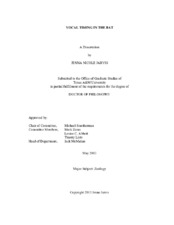| dc.description.abstract | Bats are social organisms that live in large colonies. However, reliance upon echolocation in order to hunt and navigate, means that bats also face pressing acoustic challenges due to overlap with surrounding noise. Bats also possess fine control over the properties of their echolocation pulses. This study's goal was to determine how bats are able to effectively function in large groups despite the interfering noise generated by conspecifics. Mexican free-tailed bats (Tadarida brasiliensis) were exposed to both artificially generated interfering noises and noise generated by conspecifics, and the temporal characteristics of their resulting echolocation calls were analyzed. In addition, bats were given injections of dopaminergic and serotonergic drugs, in an effort to determine which monoamine(s) were capable of altering vocal motor timing and to determine which regions of the brain play a role in regulating the timing of echolocation. I hypothesized that bats would alter the timing of emission of their own echolocation pulses in response to noise, and that drugs affecting the 5HT2A receptor would shift the timing of emission of echolocation pulses.
The first part of this dissertation describes a novel temporal alteration behavior that occurs in response to artificially generated intermittent noise, and is characterized by a period of pulse suppression followed by a gradual return to normal call rates. Bats alter the timing of emission of their echolocation pulses to avoid overlap with noise and call within silent periods. The second part of this study investigated whether dopamine or serotonin, or both, could alter the timing of this vocal behavior. The results of this study were inconclusive, although I found some evidence that 5HT2A agonists can produce faster responses. Finally, I show that echolocating bats suppress pulse emission in nearby conspecifics. The resulting decrease in call rate leads to an overall increase in information throughput. This study also demonstrates that bats respond to continuous noise by increasing their call rate, and that the switch between the responses to intermittent noise and continuous noise occurs at a duty cycle of 50% or higher. Overall, this dissertation establishes that bats alter the timing of emission of their echolocation calls in response to noise, and that these mechanisms may be regulated by serotoninergic mechanisms. | en |


